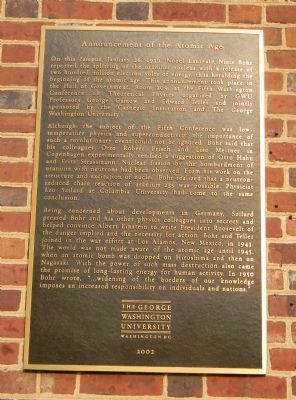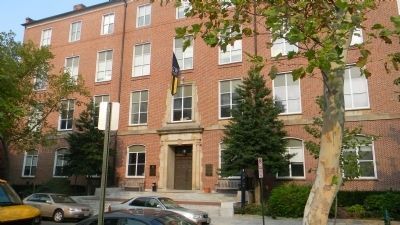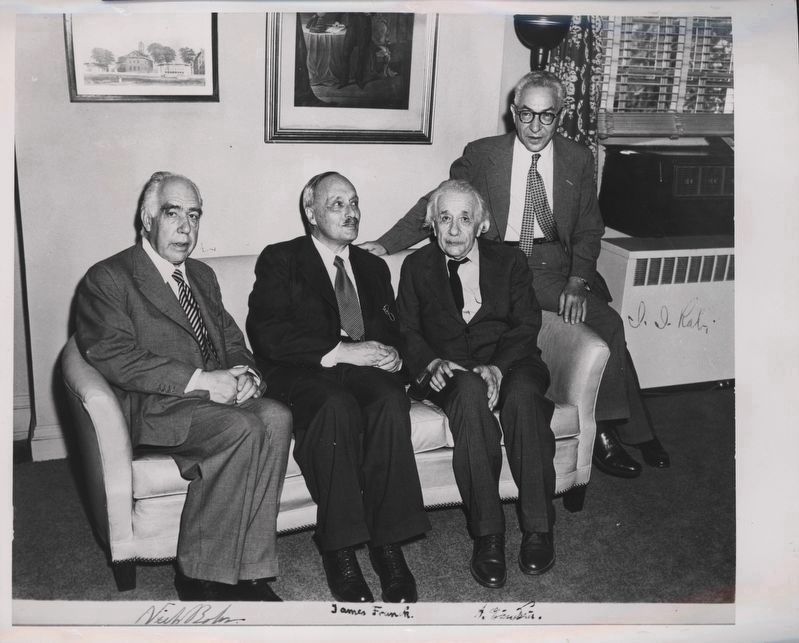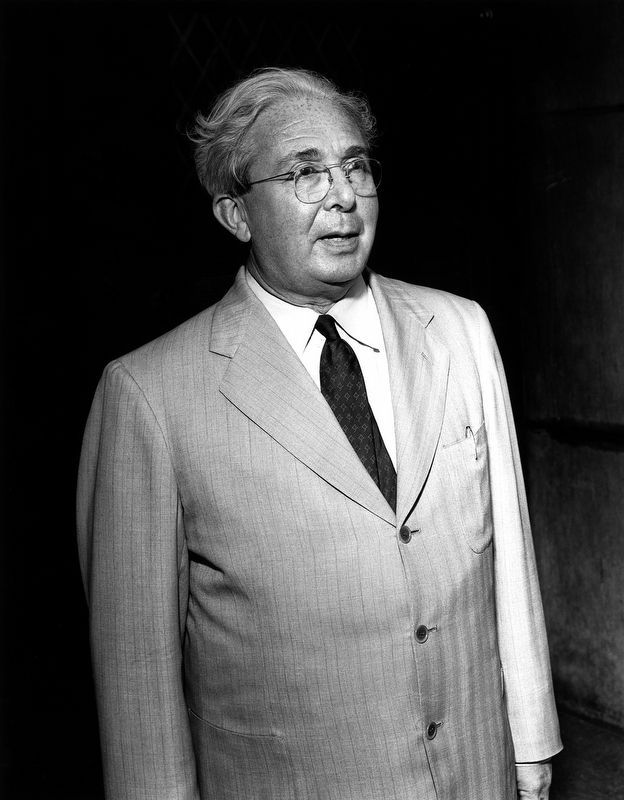Foggy Bottom in Northwest Washington in Washington, District of Columbia — The American Northeast (Mid-Atlantic)
Announcement of the Atomic Age
On this campus, January 26, 1939, Nobel Laureate Niels Bohr reported the splitting of the uranium nucleus with the release of two hundred million electron volts of energy, thus heralding the beginning of the atomic age. This announcement took place in the Hall of Government, Room 209, at the Fifth Washington Conference on Theoretical Physics organized by GWU Professors George Gamow and Edward Teller and jointly sponsored by the Carnegie Institution and the George Washington University.
Although the subject of the Fifth Conference was low-temperature physics and superconductivity, the importance of such a revolutionary event could not be ignored. Bohr said that his colleagues, Otto Robert Frisch and Lise Meitner in Copenhagen experimentally verified a suggestion of Otto Hahn and Fritz Strassmann. Nuclear fission by the bombardment of uranium and neutrons had been observed. From his work on the structure and excitation of nuclei, Bohr realized that a neutron-induced chain reaction of uranium-235 was possible. Physicist Leo Szilard at Columbia University had come to the same conclusion.
Being concerned about developments in Germany, Szilard pressed Bohr and his physics colleagues into secrecy and helped convince Albert Einstein to write President Roosevelt of the danger implied and the necessity for action. Bohr and Teller joined the war effort at Los Alamos, New Mexico, in 1943. The world was not made aware of the atomic age until 1945, when an atomic bomb was dropped on Hiroshima and then on Nagasaki. With the power of such mass destruction also came the promise of long-lasting energy for human activity. In 1950 Bohr wrote, “…widening of the borders of our knowledge imposes an increased responsibility on individuals and nations.”
Erected 2002 by The George Washington University, Washington D.C.
Topics. This historical marker is listed in these topic lists: Education • Science & Medicine • War, World II. A significant historical date for this entry is January 26, 1935.
Location. 38° 53.943′ N, 77° 2.791′ W. Marker is in Northwest Washington in Washington, District of Columbia. It is in Foggy Bottom. Marker is on 21st Street Northwest south of H Street Northwest, on the left when traveling south. Touch for map. Marker is at or near this postal address: 2036 H Street Northwest, Washington DC 20052, United States of America. Touch for directions.
Other nearby markers. At least 8 other markers are within walking distance of this marker. Edward Teller (here, next to this marker); Professors Gate (a few steps from this marker); George Gamow (within shouting distance of this marker); At GW, Being Bright Comes Naturally (within shouting distance of this marker); A Bench By The Road
(within shouting distance of this marker); GW's River Horse (within shouting distance of this marker); George Washington (within shouting distance of this marker); a different marker also named GW's River Horse (within shouting distance of this marker). Touch for a list and map of all markers in Northwest Washington.
Also see . . .
1. Niels Bohr. Wikipedia entry:
“The discovery of nuclear fission by Otto Hahn in December 1938 (and its theoretical explanation by Lise Meitner) generated intense interest among physicists. Bohr brought the news to the United States where he opened the Fifth Washington Conference on Theoretical Physics with Fermi on 26 January 1939.” (Submitted on January 19, 2019.)
2. Leo Szilard. Wikipedia entry:
“Szilard drafted a confidential letter to the President, Franklin D. Roosevelt, explaining the possibility of nuclear weapons, warning of the German nuclear weapon project, and encouraging the development of a program that could result in their creation. With the help of Wigner and Edward Teller, he approached his old friend and collaborator Einstein in August 1939, and convinced him to sign the letter, lending his fame to the proposal. The Einstein–Szilárd
letter resulted in the establishment of research into nuclear fission by the U.S. government, and ultimately to the creation of the Manhattan Project.” (Submitted on January 19, 2019.)
Additional keywords. "Niels Henrik David Bohr"; Danish
Credits. This page was last revised on February 5, 2023. It was originally submitted on September 18, 2011, by Richard E. Miller of Oxon Hill, Maryland. This page has been viewed 1,089 times since then and 64 times this year. It was the Marker of the Week January 20, 2019. Photos: 1, 2. submitted on September 18, 2011, by Richard E. Miller of Oxon Hill, Maryland. 3. submitted on January 19, 2019. 4. submitted on January 19, 2019, by J. J. Prats of Powell, Ohio. • Bill Pfingsten was the editor who published this page.



